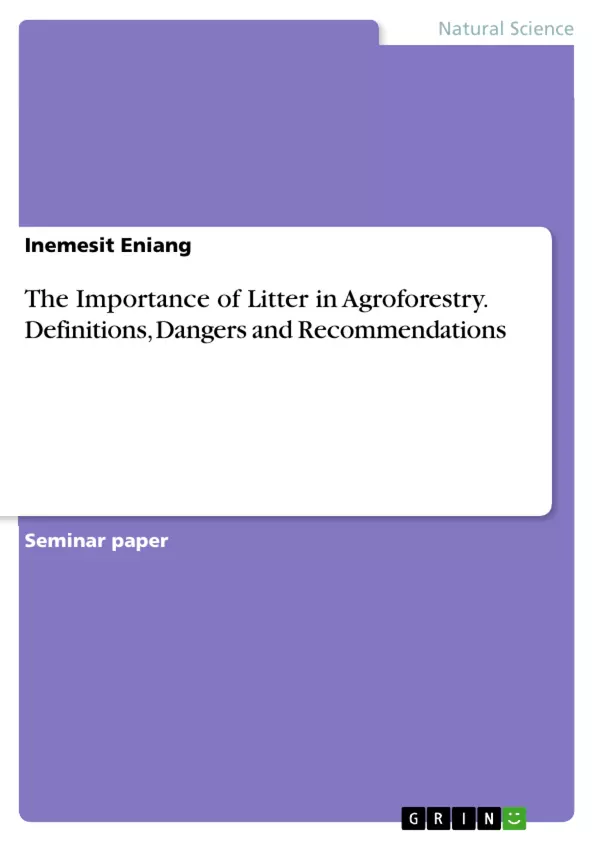This paper concerns itself with benefits and chances of agroforestry. The focus is on the importance of litter for the agroforestry ecosystem as it plays a crucial role in nutrient cycling, soil health, and overall ecosystem functioning. Basic terms and definitions will be introduced, and the impact of litter on water and biodiversity will be explained. The dangers of litter removal will be discussed and recommendations for future actions concerning litter will be shared.
Table of Contents
- Abstract
- Introduction
- Definition of Litter
Objectives and Key Themes
The objective of this paper is to explore the importance of forest litter in agroforestry ecosystems. It aims to highlight the multifaceted benefits of litter and its role in promoting sustainable agricultural practices.
- The role of forest litter in enhancing soil fertility.
- The contribution of litter to improved water infiltration and retention.
- The importance of litter in nutrient cycling within agroforestry systems.
- The impact of litter on plant performance and biodiversity.
- The connection between litter and sustainable agricultural practices.
Chapter Summaries
Introduction: This chapter introduces agroforestry as a sustainable land management system combining tree cultivation with crops and/or livestock. It emphasizes the synergistic benefits of this integration, including increased biodiversity, soil conservation, improved nutrient cycling, climate change mitigation, microclimate regulation, and diversified resilience. The chapter highlights various agroforestry practices like alley cropping, silvopastoral systems, and forest farming, emphasizing the system's adaptability to different ecological conditions and agricultural goals. The introduction lays the groundwork for understanding the crucial role of trees and their interaction with other elements within the agroforestry system, setting the stage for the subsequent discussion on the importance of forest litter.
Definition of Litter: This chapter defines forest litter as the organic material accumulating on the soil surface, composed of dead plant material (leaves, twigs, bark, etc.) and other organic matter. It concisely explains the crucial role of litter in nutrient cycling, soil health, and overall ecosystem functioning. The chapter emphasizes the importance of litter decomposition in releasing nutrients back into the soil, thereby improving soil fertility and supporting plant growth. While the chapter mentions the classification of litter components into living and non-living, the focus remains on the overall importance of litter in the ecosystem's health and its function as a key component of nutrient cycling.
Keywords
Agroforestry, forest litter, soil fertility, nutrient cycling, sustainable agriculture, biodiversity, water infiltration, plant performance, ecological resilience.
Frequently Asked Questions: A Comprehensive Language Preview
What is the main topic of this document?
This document provides a comprehensive preview of a paper exploring the importance of forest litter in agroforestry ecosystems. It covers the table of contents, objectives, key themes, chapter summaries, and keywords.
What are the key themes explored in the paper?
The paper focuses on the multifaceted benefits of forest litter, including its role in enhancing soil fertility, improving water infiltration and retention, contributing to nutrient cycling, impacting plant performance and biodiversity, and its connection to sustainable agricultural practices within agroforestry systems.
What is the objective of the paper?
The objective is to explore the significance of forest litter in agroforestry ecosystems and highlight its contribution to sustainable agricultural practices.
What topics are covered in the Introduction chapter?
The introduction defines agroforestry, highlighting its synergistic benefits like increased biodiversity, soil conservation, improved nutrient cycling, climate change mitigation, and diversified resilience. It discusses various agroforestry practices and sets the stage for understanding the crucial role of forest litter within the system.
What is the definition of forest litter as presented in the paper?
Forest litter is defined as the organic material accumulating on the soil surface, composed of dead plant material (leaves, twigs, bark, etc.) and other organic matter. Its crucial role in nutrient cycling, soil health, and overall ecosystem functioning is emphasized, particularly its contribution to improved soil fertility and plant growth through decomposition.
What are the keywords associated with this paper?
The keywords are: Agroforestry, forest litter, soil fertility, nutrient cycling, sustainable agriculture, biodiversity, water infiltration, plant performance, and ecological resilience.
What does the paper cover in terms of structure?
The preview includes a table of contents, a statement of objectives and key themes, chapter summaries (Introduction and Definition of Litter), and a list of keywords.
What types of agroforestry systems are mentioned?
The introduction mentions various agroforestry practices such as alley cropping, silvopastoral systems, and forest farming.
What is the significance of litter decomposition?
Litter decomposition is crucial for releasing nutrients back into the soil, thereby improving soil fertility and supporting plant growth.
Who is the intended audience for this document?
The intended audience is likely academics or researchers interested in agroforestry and sustainable agriculture.
- Quote paper
- Inemesit Eniang (Author), 2023, The Importance of Litter in Agroforestry. Definitions, Dangers and Recommendations, Munich, GRIN Verlag, https://www.grin.com/document/1359830



